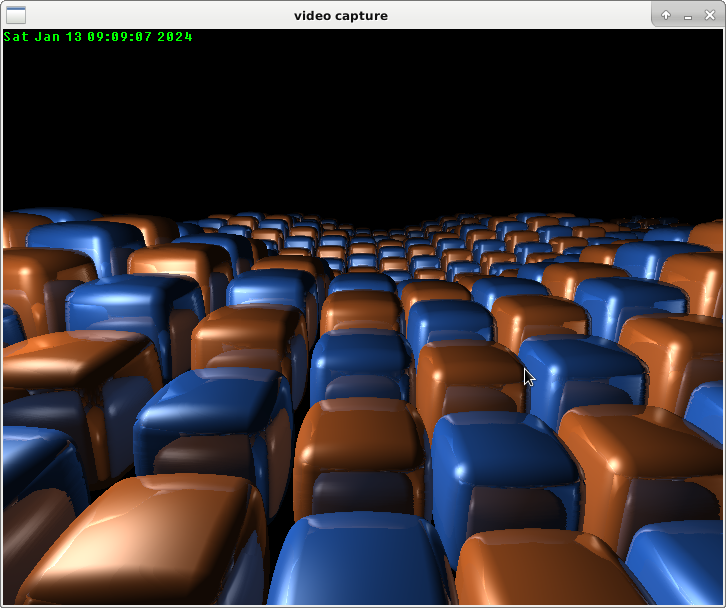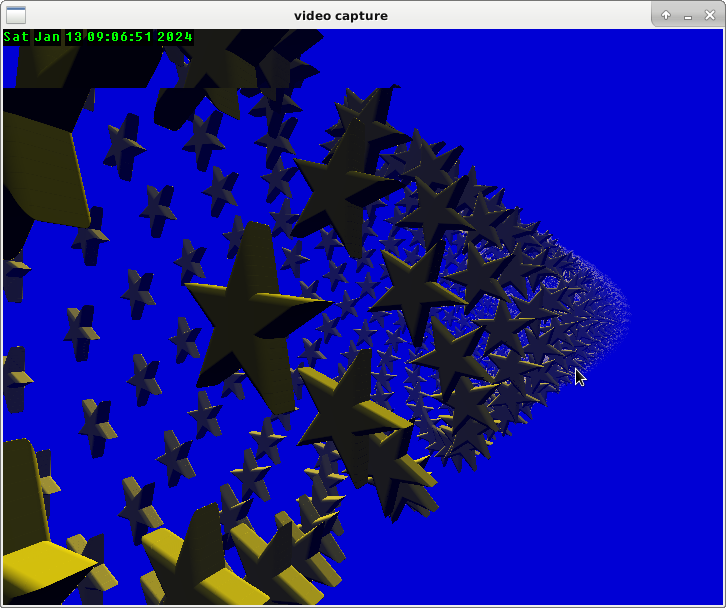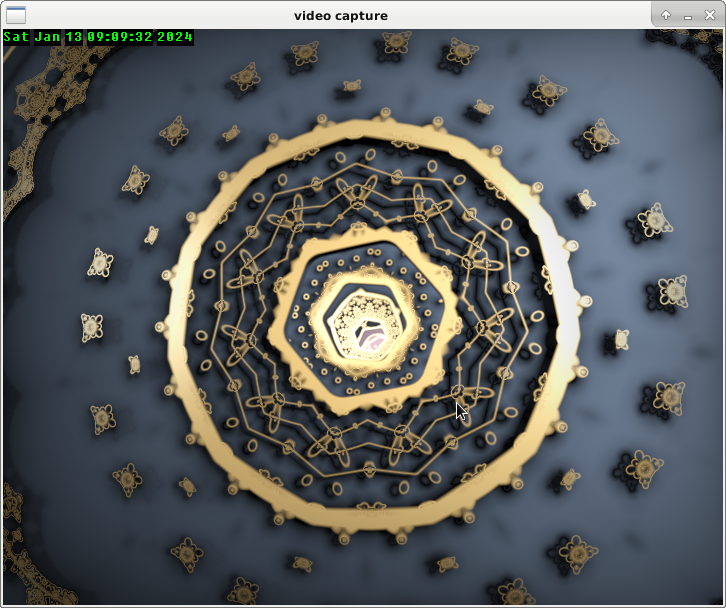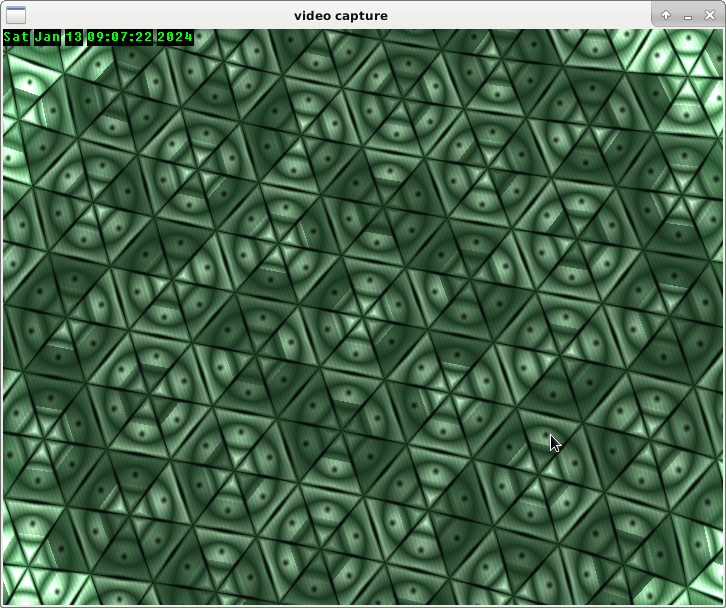Offscreen OpenGL/GLES rendering
These examples programs show:
- how to do OpenGL/GLES rendering without any windowing system,
- how to retrieve the video and play it in a window,
- how to take video snapshots in PNG or JPEG. For JPEG it uses hardware acceleration for picture encoding,
- how to encode video in h264 and h265 on the fly using hardware acceleration,
- how to stream encoded video
Should work on headless system provided that /dev/dri/renderD128 device exists.
Code shown here:
- is inspired by work found here
- uses glText from here
- uses shaders found here
- uses huge code chunks from libva-utils.
- uses a tiny TCL interpreter from picol.
There are 7 distinct programs:
- offscreen: does the rendering and stores the images (RGBA32 pixels) in a memory mapped file (defaults to
/tmp/frame). Images are generated at a given frame rate (default to 20 fps). - grab-png: takes a screenshot in PNG by reading the file filled by offscreen.
- grab-jpeg: takes a screenshot in JPEG by reading the file filled by offscreen. It uses
vaapi(Video Acceleration API) to delegate JPEG computation to the hardware. - h264enc: Encode generated frames as an h264 raw video file.
- h265enc: Encode generated frames as an h265 raw video file.
- h264streamer: Create RTSP server and RTP streams h264 raw video file. Used to stream output of h264enc
- h265streamer: Create RTSP server and RTP streams h264 raw video file. Used to stream output of h265enc
- sdl-win: Read images at a given framerate (default to 20) from the file written by offscreen which is memory mapped.
Apart for sdl-win it is easier to start grab-png, grab-jpeg, h264enc, h265enc, h264streamer and h265streamer from offscreen (see below).
Usage
offscreen
This program performs hardware accelerated video rendering using GL fragment shaders.
$ offscreen -?
usage: ./offscreen [-w width] [-h height] [-f framerate] [-o /path/to/file] [-s /path/to/fragment-shader]
-? Print this help message.
-h height Desired image height. Defaults to 720
-w width Desired image width. Defaults to 576
-f fps Number of images per second. Defaults to 20.
-o /path/to/file Path of mmap-ed file that will hold image. Defaults to '/tmp/frame'.
-s /path/to/file Path of of fragent shader. Defaults to 'shaders/plasma.frag'
There is a crude command interface which is based on a tiny TCL interpreter. If started from a terminal the program displays a prompt.
$ ./offscreen
The output file was opened successfully.
The output file was mapped to memory successfully.
offscreen renderer cli. Type 'help' to see available commands.
=> help
colorspace ?rgb/yuv?
execbg command ?arg1? ... ?argn?
fps ?frame-per-second?
kill ?add/rm pid?
message ?msg?
mouse ?x y?
shader ?/path/to/fragment-shader?
stats
width
height
help ?topic?
quit ?status?
=> help fps
With no argument, returns current video framerate. Otherwise sets framerate according to argument. Valid values are integer between 1 and 100.
There are commands for taking snapshots (jpeg and png) and recording video, at offscreen prompt enter:
=> png /path/to/capture.png
=> jpeg /path/to/capture.jpeg
=> h264enc /path/to/video.264 1000 ;# will record 1000 video frames
=> h265enc /path/to/video.265 1000 ;# will record 1000 video frames
Note that jpeg, h264 and h265 use hardware acceleration using VAAPI.
sdl-win
$ ./sdl-win -?
usage: ./sdl-win [-?] -i file [-f fps] [-x x] [-y y] [-w width] [-h height]
-? Prints this message.
-i Set input video frame file (default /tmp/frame).
-f Set the video framerate (default 20).
-w Set the width of the image (default 720).
-h Set the height of the image (default 576).
-x Set the x position of the window (default 100).
-y Set the y position of the window (default 100).
grap-png
$ ./grab-png -?
usage: ./grab-png [-?] -i file -o file [-w width] [-h height]
-? Prints this message.
-i Set input video frame file (default /tmp/frame).
-o Set output PNG file name (default /tmp/capture.png).
-w Set the width of the image (default 720).
-h Set the height of the image (default 576).
-s Encode input on SIGUSR1 signal. Wait at most 10 sec for signal.
It is easier to start grab-png from offscreen using the png command like this:
$ ./offscreen
==> png /path/to/capture.png
==> quit
It will start grab-png, change colorspace to RGB, send a SIGUSR1 signal to grab-jpeg process.
grab-jpeg
$ ./grab-jpeg -?
usage: ./grab-jpeg [-?] -i file -o file [-w width] [-h height]
-? Prints this message.
-i Set input video frame file (default /tmp/frame).
-o Set output JPEG file name (default /tmp/capture.jpeg).
-w Set the width of the image (default 720).
-h Set the height of the image (default 576).
-f Set 4CC value 0(I420)/1(NV12)/2(UYVY)/3(YUY2)/4(Y8)/5(RGBA) (default 5).
-q Set quality of the image (default 50).
-s Encode input on SIGUSR1 signal. Wait at most 10 sec for signal.
Example: ./grab-jpeg -w 1024 -h 768 -i input_file.yuv -o output.jpeg -f 0 -q 50
It is easier to start grab-jpeg from offscreen using the png command like this:
$ ./offscreen
==> jpeg /path/to/capture.jpeg
==> quit
It will start grab-jpeg, change colorspace to YUV, send a SIGUSR1 signal to grab-jpeg process.
For the moment, only 4CC RGBA is supported. But it is not real RGBA, you need to perform rendering in YUV colorspace by entering colorspace yuv at offscreen command prompt.
h264enc
$ ./h264enc -?
./h264encode <options>
-w <width> -h <height>
-framecount <frame number>
-n <frame number>
if set to 0 and srcyuv is set, the frame count is from srcuv file
-o <coded file>
-f <frame rate>
--intra_period <number>
--idr_period <number>
--ip_period <number>
--bitrate <bitrate>
--initialqp <number>
--minqp <number>
--rcmode <NONE|CBR|VBR|VCM|CQP|VBR_CONTRAINED>
--srcyuv <filename> load YUV from a file
--entropy <0|1>, 1 means cabac, 0 cavlc
--profile <BP|MP|HP>
--low_power <num> 0: Normal mode, 1: Low power mode, others: auto mode
It is easier to start h264enc from offscreen using the h264 command like this:
$ ./offscreen
==> h264 /path/to/video.h264 1000 ;# will record 1000 video frames
INPUT:Try to encode H264...
INPUT: RateControl : CBR
INPUT: Resolution : 720x576, 1000 frames
INPUT: FrameRate : 20
INPUT: Bitrate : 1990656
INPUT: Slices : 1
INPUT: IntraPeriod : 30
INPUT: IDRPeriod : 30
INPUT: IpPeriod : 1
INPUT: Initial QP : 26
INPUT: Min QP : 0
INPUT: Source YUV : /tmp/frame (fourcc NV12)
INPUT: Coded Clip : /path/to/video.h264
libva info: VA-API version 1.4.0
libva info: va_getDriverName() returns 0
libva info: Trying to open /usr/lib/x86_64-linux-gnu/dri/i965_drv_video.so
libva info: Found init function __vaDriverInit_1_4
libva info: va_openDriver() returns 0
Using EntryPoint - 6
Use profile VAProfileH264High
Support rate control mode (0x96):CBR VBR CQP
Support VAConfigAttribEncPackedHeaders
Support packed sequence headers
Support packed picture headers
Support packed slice headers
Support packed misc headers
Support 4 RefPicList0 and 1 RefPicList1
Support 32 slices
Support VAConfigAttribEncSliceStructure
Support VA_ENC_SLICE_STRUCTURE_ARBITRARY_MACROBLOCKS
\P 00000999(007333 bytes coded)
PERFORMANCE: Frame Rate : 19.66 fps (1000 frames, 50868 ms (50.87 ms per frame))
PERFORMANCE: Compression ratio : 73:1
PERFORMANCE: Processing : 12138 ms (12.14, 23.86% percent)
PERFORMANCE: UploadPicture : 346 ms (0.35, 0.68% percent)
PERFORMANCE: vaBeginPicture : 6 ms (0.01, 0.01% percent)
PERFORMANCE: vaRenderHeader : 45 ms (0.04, 0.09% percent)
PERFORMANCE: vaEndPicture : 2130 ms (2.13, 4.19% percent)
PERFORMANCE: vaSyncSurface : 860 ms (0.86, 1.69% percent)
PERFORMANCE: SavePicture : 183 ms (0.18, 0.36% percent)
PERFORMANCE: Others : 47298 ms (47.30, 92.98% percent)
==> quit
It will start h264enc, change colorspace to YUV, send a SIGUSR1 signal to h264enc process after each new frame is ready.
h265enc
$ ./h265enc -?
./hevcencode <options>
-w <width> -h <height>
-framecount <frame number>
-n <frame number>
-o <coded file>
-f <frame rate>
--intra_period <number>
--idr_period <number>
--ip_period <number>
--bitrate <bitrate> Kbits per second
--initialqp <number>
--minqp <number>
--rcmode <NONE|CBR|VBR|VCM|CQP|VBR_CONTRAINED>
--syncmode: sequentially upload source, encoding, save result, no multi-thread
--srcyuv <filename> load YUV from a file
--fourcc <NV12|IYUV|YV12> source YUV fourcc
--profile 1: main 2 : main10
--p2b 1: enable 0 : disalbe(defalut)
--lowpower 1: enable 0 : disalbe(defalut)
It is easier to start h265enc from offscreen using the h265 like h264 command does for h264enc.
h264streamer
$ ./h264streamer -h
usage: ./h264streamer [-i /path/to/file] [-s stream-name]
-? Print this help message.
-i /path/to/file Path to input raw h264 vide file. Defaults to 'test.h264'.
-s stream-name Name of stream used for RTSP URL. Defaults to 'testStream
This program can stream an h264 elementary stream (sequence of NAL units) generated using h264enc.
Using a FIFO (named pipe created with mkfifo as output of h264enc and as input of h264streamer a 'realtime' h264-encoder-streamer pipeline is created. This is what does the offscreen command h264stream.
$ ./offscreen
The output file was opened successfully.
The output file was mapped to memory successfully.
offscreen renderer cli. Type 'help' to see available commands.
=> h264stream 10000 ;# will stream 10000 frames
INPUT:Try to encode H264...
INPUT: RateControl : CBR
INPUT: Resolution : 720x576, 10000 frames
INPUT: FrameRate : 20
INPUT: Bitrate : 1990656
INPUT: Slices : 1
INPUT: IntraPeriod : 30
INPUT: IDRPeriod : 30
INPUT: IpPeriod : 1
INPUT: Initial QP : 26
INPUT: Min QP : 0
INPUT: Source YUV : /tmp/frame (fourcc NV12)
INPUT: Coded Clip : /tmp/h264fifo
libva info: VA-API version 1.4.0
libva info: va_getDriverName() returns 0
libva info: Trying to open /usr/lib/x86_64-linux-gnu/dri/i965_drv_video.so
libva info: Found init function __vaDriverInit_1_4
libva info: va_openDriver() returns 0
Using EntryPoint - 6
Use profile VAProfileH264High
Support rate control mode (0x96):CBR VBR CQP
Support VAConfigAttribEncPackedHeaders
Support packed sequence headers
Support packed picture headers
Support packed slice headers
Support packed misc headers
Support 4 RefPicList0 and 1 RefPicList1
Support 32 slices
Support VAConfigAttribEncSliceStructure
Support VA_ENC_SLICE_STRUCTURE_ARBITRARY_MACROBLOCKS
--------------------------------------------
Note RTSP URL below to play stream
--------------------------------------------
--------------------------------------------
=> Play this stream using the URL "rtsp://192.168.1.30:8554/h264"
Beginning streaming...
Beginning to read from file...
\P 00000279(011028 bytes coded)
Note the name of the coded video which is actually a FIFO /tmp/h264fifo.
To view the stream use vlc rtsp://192.168.1.30:8554/h264. VLC will buffer the stream for about 1 second resulting in a 1 second delay.
The video pipeline has 3 processes:
offscreenh264ench264streamer
offscreen and h264enc mmap the same file which contains a YUV image. offscreen signals (SIGUSR1) h264enc each time a new image is ready. offscreen sets the pace of the pipeline.
h264enc and h264stream communicate using a FIFO. h264stream reads data from the FIFO blocking if no data is available. h264enc writes data in the FIFO at the pace fixed by offscreen.
TODO: evaluate latency of the pipeline.
h265streamer
$ ./h265streamer -h
usage: ./h265streamer [-i /path/to/file] [-s stream-name]
-? Print this help message.
-i /path/to/file Path to input raw h265 video file. Defaults to 'test.h264'.
-s stream-name Name of stream used for RTSP URL. Defaults to 'testStream
This program can stream an h265 elementary stream (sequence of NAL units) generated using h265enc.
See h264streamer section.
Demo
In a first terminal run offscreen:
$ ./offscreen -w 800 -h 600 -s shaders/voronoi.frag
In a second terminal run sdl-win which will displayed an animated graphic:
$ ./sdl-win -w 800 -h 600
You should see something like this:
In the first terminal, the offscreen prompt => is displayed.
Type help to see the list of available commands and help <<command>> to get help on a specific command..
Framerate and shader can be changed dynamically using fps and shader command.
The message printed on the video can be changed using message command.
Gallery
Plasma
Circles
City
Cues
eurotunnel
nested
pavage
pipes
stars
Building
Type make to build all the programs.
There are some prerequisites, given here on debian 10 buster used during development.
libpng-devlibsdl2-devlibgbm-devlibgles2-mesa-devlibegl1-mesa-devliva-dev
Windows WSL2
It is possible to use the offscreen program under WSL2 (tested on ubuntu-20.04).
On this system the device /dev/dri/renderD128 is present and can be used.
Probably mesa will not be able to initialize properly without help and you will get a message like this:
MESA-LOADER: failed to open vgem: /usr/lib/dri/vgem_dri.so: cannot open shared object file: No such file or directory (search paths /usr/lib/x86_64-linux-gnu/dri:\$${ORIGIN}/dri:/usr/lib/dri, suffix _dri)
failed to load driver: vgem
To circumvent this issue, you need to help mesa to choose the right libray to load. For example:
export MESA_LOADER_DRIVER_OVERRIDE=i965
grab-png which does not rely on graphic hardware (doesn't use /dev/dri/renderD128) works out of the box.
WSL2 has a builtin graphical wayland based backend named wslg which can be used to run X11 program. sdl-win wasn't working on it at the tie of writing. It worked and has been tested using MobaXterm X11 server with moba version 21.2, the following server modes works (others don't):
- "Windowed mode": X11 server constrained to a single container window
- "Windowed mode with DWM": X11 server with DWM desktop in a container window
- "Windowed mode with Tvwm desktop": X11 server and Fvwm desktop in a container window
- "Rootless": Transparent X11 server with Fvwm window borders (experimantal)
For MobaXTerm X11 server to work package xauth must be installed and environment variable XAUTHORITY needs to be defined:
$ export XAUTHORITY=/home/wsluser/.Xauthority
VAAPI video encoding
Starting point is libva-utils
For i965 driver, the following package from non-free section needs to be installed.
$ sudo apt-get install i965-va-driver-shaders
Future directions
- Add circular buffer of frames. At least 2.
- Add RTP raw video streaming as an external program which consumes frames (like
sdl-winandgrap-png). - Add H264/H265 video RTP streaming backend using
vaapi+live555==> WORK in PROGRESS - Add an SDL based hardware accelerated video decoder.









